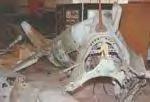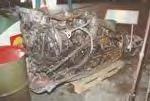e-mail spitfirefactory@aol.com
Kind Regards to The Fighter Collection and Jane Larcombe jlarkstfc@hotmail.com for their co-operation with this page.
RK858 arrived as a very distressed LF Mk IX Spitfire at Duxford in early September of 1992. The aircraft had been recovered from a crash site on the Russian steppes earlier in the year and transported in a crate across Europe and into the hangar, before being stored.
The airframe parts have been in storage since that time, although an attempt to contract for the restoration of the aircraft was made with Historic Flying Ltd of Audley End, but this fell through at the time that HFL changed hands.
The following is a brief history of the aircraft.
The Spitfire was ordered under contract B981687/39/C.23(c), which was the 13th order for 100 Mk IX Spitfires and dated the 25th of October 1943. All the aircraft in this particular order were built at the Castle Bromwich Aircraft Factory (CBAF) in the UK midlands as Mk IX/XVI's from August to October 1944.
RK799 was the first of the batch to be delivered, on the 16th of August 1944 and the last delivered was RK925 on 11th of October the same year. Serials were in the range RK798-819, RK834-868 and RK883-926.
RK858 was allotted the CBAF build number 9746 and fitted with a Merlin 66 engine. When she had been air tested from Castle Bromwich, she was issued to 33 Maintenance Unit (MU) at RAF Lyneham on the 2nd October 1944 before passing on to 52 MU nine days later to be prepared for her transportation to Russia, where she arrived on the 8th of December having travelled on the ship 'The Empire Stalwart'.
Details of her Russian service are just non-existent, unless anyone out there knows different, and the next thing we know about her, apart from the obvious and massive forced landing after being shot down, is her arrival at Duxford.
She was in very poor condition when she did arrive, with the engine all smashed up, the leading edges of the wings caved in and the fuselage bent into an 'L' shape. The wings were both still attached, testimony to the strength inherent in the design of the wings, but they were removed on arrival (well... one was, the other wouldn't come off as the last pin had jammed and the wing had to be simply folded up out of the way).
The cockpit was gutted, rudder pedals were still there but that was about it. There were no instruments left and the spade grip and many of the internal fittings were missing. The aircraft was bare metal inside the fuselage, having never been painted properly.
The Frame 5 data plate was missing, which meant we weren't going to get an easy win as far as the aircraft's RAF serial number was concerned. As it turned out we needn't have got too concerned about that as the serial was written in at least two other places around the fuselage and the CBAF build number could easily be traced.
On its arrival at Duxford, RK858 was in 4 sections:

1 The fuselage from the rear of the cockpit was crumpled and crushed. The tail was still marked with a red star, although it was far from distinct. The fuselage also bore the outline of a red star but more visible is the RAF roundel on the fuselage side.
'858 just visible in black paint on the port side and 'RK' visible on the starboard, both in the positions normally associated with RAF serial numbers, although we couldn't necessarily take this to be absolute confirmation of the original serial.
However, the upper fuselage fuel tank was also found to carry 'RK858' in original marker on the original silver paint finish. The rudder and tail controls were mostly gone from the inside of the cockpit, which wasn't painted inside. The aerial mast was in place on the top of the fuselage behind the canopy but there was no internal equipment.
'858' was written in pen inside the fuselage at the rear of cockpit on the bare metal of the port side. The fuselage sky band was still just visible forward of the tail plane. A plate on the port tailplane end reads 'CBAF 18730, 30018, SHT19' but the plate atop the rudder post is too corroded to read. A plate on frame 5 (not the main plate unfortunately) reads 'CBAF 9746, MOD 613'. It is this confirmation of the CBAF number which confirms the serial tie up.

2 The starboard wing is essentially complete and still carries the undercarriage leg. The leading edge is completely crushed inwards and upwards, showing how hard the aircraft must have hit the ground.
The crushing effect is along the length of the leading edge 'D' torsion box on both wings. The wing skins are mangled, and are holed where the wheel well is, and the cannon covers are missing.
The wing tips are in situ, despite the aircraft being being an LF IX (this designation was dependent more on the type of engine fitted to the aircraft rather than the state of the wing tips), and were fitted at CBAF judging by the paint work.
The starboard aileron inner edge bears plate which reads 'W B LTD/CBAF/, 104207, MOD 150, 319B'. A second plate confirms the aircrafts serial number, but is too corroded to read further.
Both wings were still on the cockpit section on arrival at Duxford, but then the starboard wing was removed on the 6th Sept '92 to ease the problems of storing the machine. The port wing wouldn't come off and is still in situ. Paint is original RAF including lettering, with the later applied star outline still visible. The cannon are still with the airframe.

3 The port wing and cockpit section showed the same heavy impact damage as the starboard wing, although the wing section outboard of the cannon bay had broken off completely and was missing.
The undercarriage leg and wheel were both intact and the cannons also survived to arrive at Duxford with the aircraft, odd as the cockpit had been completely ransacked. In the cockpit itself, bullet holes are evident in the skins.
The rudder pedals, control column (without the grip), fuselage side controls (throttle, airscrew control, rudder trim, gear select, fuel select), underbelly light and much wiring are all present. The instruments and the instrument panel however, have long since gone.
The floor and cockpit sides are crumpled consistent with the last landing. The lower fuselage tank is still in situ, but holed, presumably by German bullets or cannon shells.
The canopy top section is no longer there and no kill marks are visible on the outside of the cockpit. On the floor of the cockpit and under the place where the instrument panel used to be there is just a tangle of wire and cable. The port inner flap bears two plates, first reads: 'serial no. W B LTD/CBAF 90378, 30069, SMT1, PORT', second reads 'W B LTD/CBAF/90378, MOD195'.

4 The Merlin 66 engine was heavily crushed on the underside, the crankcase is all caved in and the crankshaft itself exposed, in a way consistent with a forced but crudely controlled landing (ie nose first, the right way up, steep but nowhere near vertical).

The engine must have separated from the fuselage early in the impact as it looks to have survived reasonably well apart from the initial impact damage, and must have been off the aeroplane to allow the wing leading edges to have crumpled so badly.
The four bladed prop boss still in situ, although the spinner is missing and the wooden prop blades are all sheared at their bases. The top cowling is still with us and looking fairly intact.
If you are interested in using one or more of our aircraft for Airshow or Film work, please contact Jane Larcombe, via either email jlarkstfc@hotmail.com or phone (+44) 01223 834973.
For all other enquiries please use the contact information below.
E-mail us at:
tfc@duxford.org
Write
to us at:
The
Friends of The Fighter Collection
Imperial War Museum
Duxford Airfield
Duxford
Cambridgeshire
CB2 4QR
ENGLAND